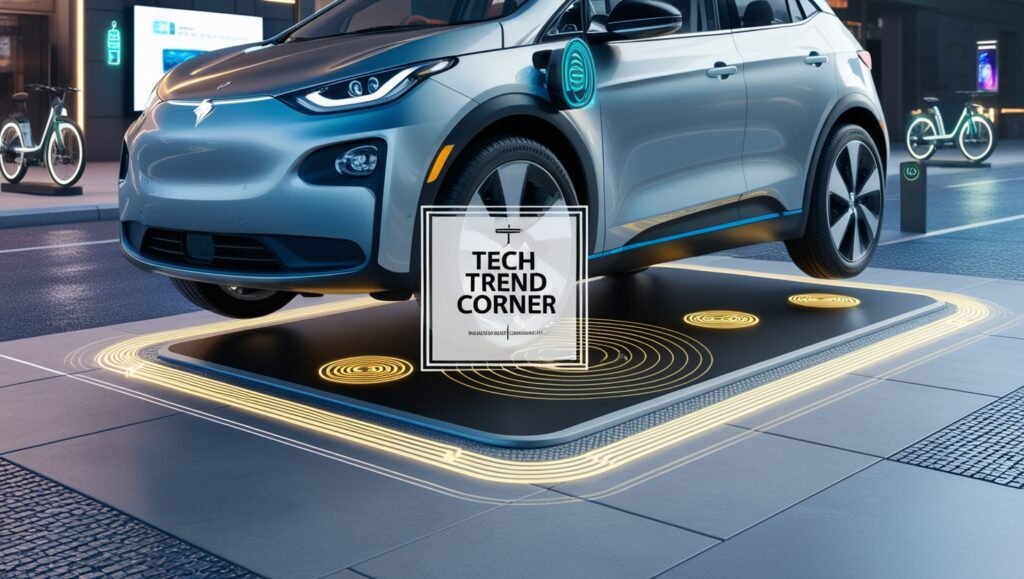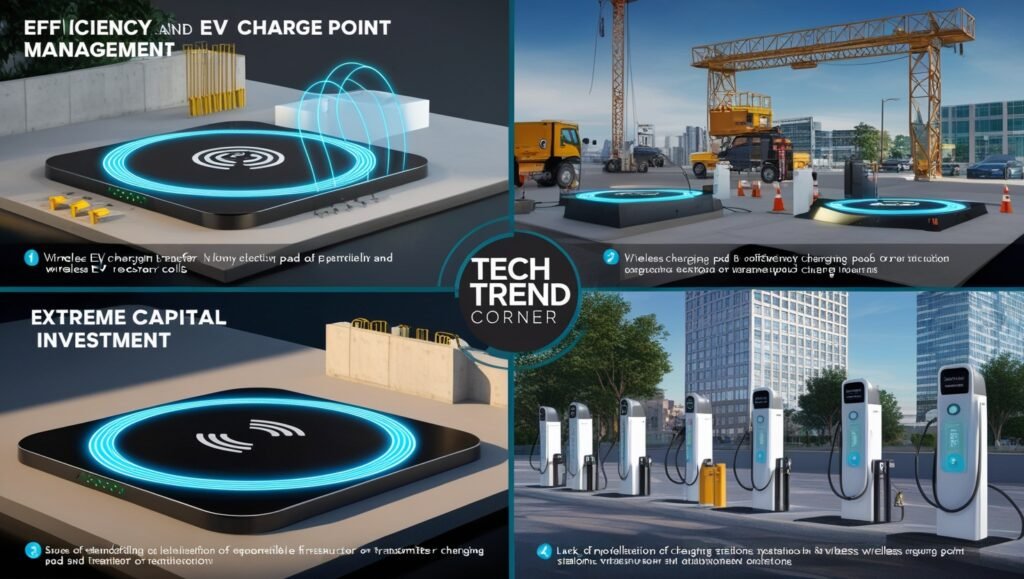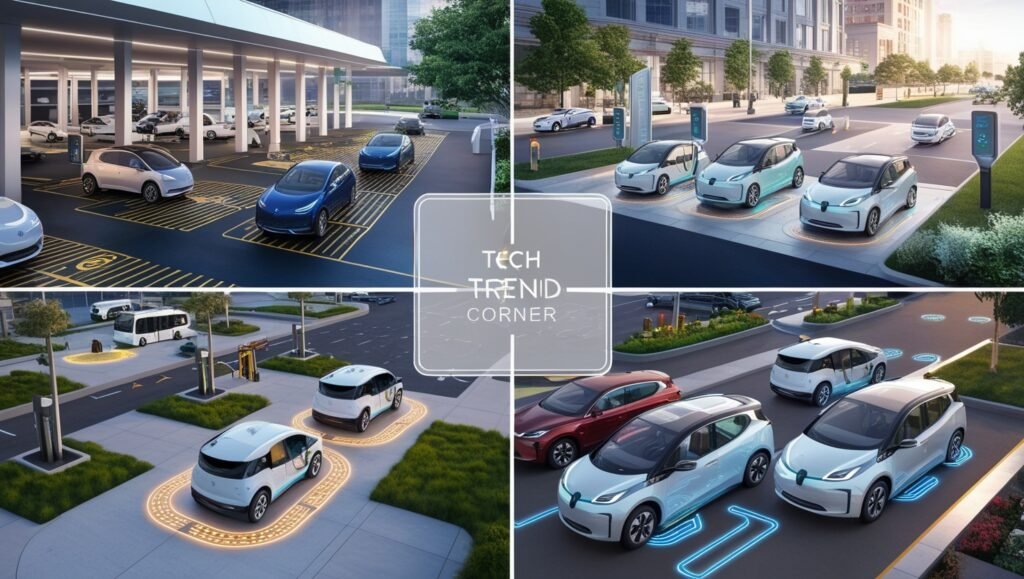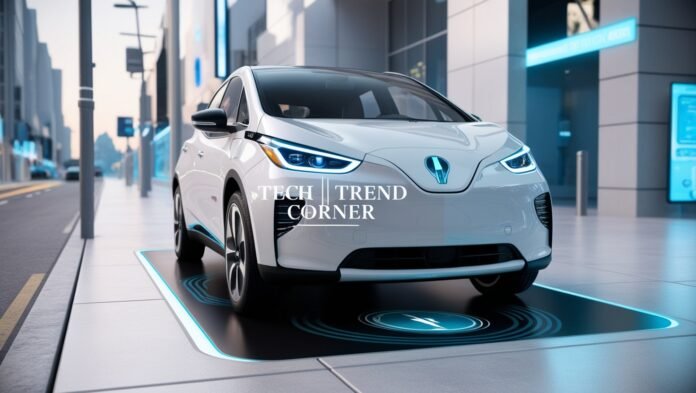As electric vehicles (EVs) rise to dominance in the automotive industry, it is bound to say that the industry is following a paradigm shift. One of the, if not the most interesting issues developed in this respect is the wireless charging of electric vehicles, which may completely change the way we fill up cars with e-fuels. Such an emergence of technology can shift the perspectives regarding comfort, productivity, and the universal transportation systems in use today. Therefore, we will discuss wireless EV charging in more depth in this article. We will examine its advantages and disadvantages, and how it might change the landscape of transportation.
What is Wireless EV Charging?
Wireless EV charging, also known as inductive charging, is a technology that lets electric vehicles be charged without physical cables or connectors. Rather, it employs magnetic fields in transferring energy from two coils: one is embedded in the ground and the second in the vehicle. It is similar to how mobile phone wireless charging pads function, except this is tweaked to meet the voltages of an electric vehicle.
The operation principle of this technology is based on electromagnetic induction – it is when AC (alternating current) flowing in the transmitter coil generates a magnetic field. The current produced as a result of such a magnetic field in turn develops in the coil within the e-vehicle and is then turned back to charge the battery of the e-vehicle.
How Effective is Charging with No Hubs?
As previously discussed, charging an electric vehicle wirelessly involves inducing an electric current between two magnetic surface coils. A car charging system is installed on the ground, comprising of a transmitter coil and a charger in the car with a receiver coil. This arrangement is commonly called inductive power transfer (IPT) and covers both electric vehicles and wireless cell phone chargers.

Both the transmitter and receiver coils are adjusted to a particular frequency thus making energy transfer possible via the coils. The energy collected in this manner is used to charge the electric vehicle’s battery. The electric bike wireless charging system does not need to fit a plug-in wire into a socket. It is designed for convenience to enable charging of electric vehicles without the need to connect the vehicle to the charging station using physical terminals.
Advantages of Wireless EV Charging
There are several benefits that wireless EV charging offers not only to vehicle owners but also the entire network of electric vehicles. Some essential benefits are discussed below:
1. Comfort and Simplicity of Operation
Comfort is one of the most notable advantages of wireless EV charging. Drivers do not have to bother about connecting any cables which is an added advantage especially when it is raining, or there is little space to park. It is as easy as parking over the charging pad to initiate the charging process. Such ease of use makes the growth in the uptake of electric vehicles more seamless for the average person.
2. Improved Security
Since wireless charging avoid use of wires, there are also reduced risks of any electrical hazards such as tripping over cables or short circuiting the cables. There are no wire connections or plugs that can cause any injury. Furthermore, the primary purpose of a wireless charging system is to damage the electric vehicle or the charging station in case of internal failure.
3. Diminished Usage
It is a well-known fact that standard charging cords can become old and tear after using them several times. When it comes to wireless charging, there are no such plastic or metallic connectors, which can be rendered non-functional. One, therefore, avoids issues with damage to the charging port of the vehicle and the charging station, hence less maintenance needed and more extended working life of the charging system.
4. Aesthetics and Design Flexibility
Without a doubt, wireless charging stations can be placed on the parking surface or under the ground. This accommodating design brings about a neater appearance as there will be no charging cables that will cause messiness. It also enhances aesthetic features of the application with solutions such as a system road or driveway which perform charging functions.
5. Possibility of Charging When the Vehicle is in Motion
Arguably the best feature about the wireless EV charging technology is the possibility of charging the vehicles on the move. It implies that vehicles would also be charged when they are on the go or in motion. There are prospects in the future of driverless cars with built-in wireless charging pads along the roads so that cars are charged as they move, thereby increasing the distance covered by the car and minimizing the number of charging stops made.
Hurdles Present in Electric Vehicle Charge Point Management
Notwithstanding the clear benefits of WPT systems for electric vehicle-adoption, there are cloud several barriers that need to be overcome. Out of these barriers, the most important ones are:
1. Efficiency and Power Transfer
At this moment, the performance of under-road wireless EV charging systems is lower than that of conventional charging stations with plugs. Additionally, there can be a pose effect, where the coils that transfer energy are misaligned from the charging pad because the vehicle relies on the pad. There, in turn, charge times are high in comparison with the wired systems. Nevertheless, the technology is constantly developing, and efficacy is expected to improve. Therefore, in the upcoming days, perhaps there will be rapid systems.
2. Extreme Capital Investment
The cost of preparing the site for installation of a wireless charger exceeds the cost of plain installation of a wired charger. Infrastructure like the necessary ground coils and receiver systems for wireless charging increase the cost of wireless charging equipment. Wireless charging is still in its infancy allowing for the establishment of high price points. Hence the time frame where this technology will be defined as normal may not be reached.

3. Issues Related to Standardization
Another obstacle is the absence of standardization between different manufacturers. A number of different wireless charging systems are under development at present, but they may not be complementary to one another. For acceptance on a larger scale, a global standard has to be found so that all electric vehicles (EVs) will be able to use any wireless charging system.
4. Lack of Proliferation of Charging Stations
There are not enough locations where one can use a Wireless Electric Vehicles charging infrastructure as it is still very primitive. At this point in time, Places where wireless charging station are accessible are mostly research centers with a few public charging units available. Such technology will take time before deployment as limo service demand the technology for their electric vehicles.
Looking Forward to Wireless EV Charging
The perspective concerning cordless charging of electric vehicles (EVs) sees better prospects in the years to come especially with the improvements to be made. Wire charging systems are bound to get better and wider in scope that there is no doubt even non-experts agree. Some potential changes to expect include the following:
1. Inclusion in the Smart Cities Concept
Considering the smart connectivity over the existing infrastructure in the cities that are more developed than others, it is logical to think Ev wireless charging would be part of the smart structure of these cities. It may be possible to construct charging pads inside public car parks, along highways or even within the road so that cars can be charging themselves on the move within the confines of the city. This may greatly eliminate the challenges associated with the need for installing specific charging areas and enable easy battery charge resumption for electric vehicle owners who are moving around.
2. Fueled by Dynamic Charging
While public charging stations can be considered a temporary solution, dynamic charging – charging while driving the car – is the ultimate wireless electric vehicle charging objective. This idea has not yet taken root, yet a few test cases are currently in place that is looking at dynamic road charging on motorways. This would help install drop-in charger points for the convenience of the drivers for electric vehicles.
3. Enhanced Efficiency and Rate of Charging
The efficiency of wireless charging systems remains the paramount focus on the ongoing research and development works. It is anticipated that there will be wireless chargers ofThe future will wireless chargers be able to transfer the power more efficiently thereby minimizing the time taken to charge the devices and making the system more favourable than the old models of plug in charging. With the proliferation of wireless charging in electric vehicles, there shall also be advancement and adoption of the technology in the near future.
4. Economical and Wide Accessibility
It can also be expected that with the growing adoption of EV Wireless Charging Technology, the expenses related with the installation and infrastructure would be minimized. billing stations convexities would lead to charging stations that are less expensive thereby facilitating a wider embrace of the wireless charging systems. This will motivate more private enterprises and government facilities to put up more of such charging units.
The Importance of Wireless EV Charging for Sustainable Transportation
Wireless EV charging, in addition, supports sustainable transportation in a great way. The world is changing towards cleaner energy and with the comfort of wireless charging, electric cars will be embraced much faster. Less dependency on fossil fuels and advocating for clean energy by way of charging without wires, would help in enhancing the global fight against climate change.
Conclusion
In the electric vehicle market, wireless EV charging is touted to be a beneficial innovation. There are challenges that remain, however, the advantages — of which convenience, safety, and efficiency come to mind — make it an exciting technology to look forward to. Looking ahead with ever more progress and acceptance, the expectation is that wireless charging will be an everyday attribute of not just electric vehicles but also the respective charging infrastructures. In this more environmentally conscious age and active drive toward less dependence on fossil fuel sources, wireless EV charging will support the further inroads made by electric vehicles more than any other technology.

It will also be fascinating to watch the transformation in mobility that this technology promises, making it easier for more drivers around the world to use electric vehicles (EVs).
Read more about EV Battery Life and Warranty: Ultimate Protection Guide.
Frequently Asked Questions
1. Definition of Wireless Electric Vehicle Charging?
Wireless Electric Vehicle charging or inductive charging refers to the charging of electric vehicles without physical cables. It employs the principle of electromagnetic induction between some coils placed on the ground and inside the vehicle, much like wireless phone chargers but on higher voltages.
2. What are the Main Advantages of Wireless EVC?
The greatest advantage of wireless charging is that there are no cables needed, thus there is a lesser risk of electrical hazards. Maintenance is less required, better design can be done for the charging stations, and the possibility of charging the car while driving exists.
3. What Challenges Does Wireless EV Charging Face?
Key barriers include low efficiency and power transfer relative to wired systems, high capital investment requirements, lack of conformity between manufacturers, and a sparse network of charging yards which presently limits its general uptake.
4. How Could Wireless EV Charging Transform Future Transportation?
In the future, wireless charging may be incorporated into smart cities through the use of charging pads designed to be aesthetically pleasing within urban areas, provide dynamic charging capabilities to moving vehicles, enhance efficiency of charging, and become cheaper and widespread, resulting in the growing popularity of electric cars and eco-friendly transport.
5. Is Wireless EV Charging Efficient Compared to Traditional Charging?
Some of the shortcomings of the current technologies used in wireless power transmission include occasional misalignment of the coils in the transmitter and receiver as well as energy dissipating in the environment. Fortunately, new technologies are under development which will improve the efficiency and speed of charging thus making it possible to compete with plug systems.

